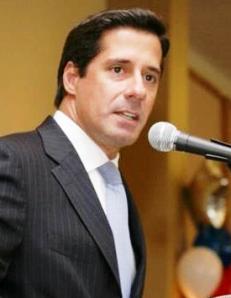Florida School Districts Preparing For Central American Immigrants
Jessica Gaspar was born in the U.S. and grew up speaking English at school — but at home, she speaks Q’anjob’al.
That’s the Mayan language spoken by her Guatemalan parents.
She said she and her brother struggled to practice their English once the school day ended. It’s why Gaspar volunteers at a community center on a back street lined with body shops in Lake Worth.

Miami-Dade schools.
More than 100 Honduran students have enrolled in Miami Jackson Senior High School the past two years. Principal Carlos Rios says the school must make sure their basic needs are met.
She’s helping new, young immigrants at the Guatamalan-Maya Center learn the basics – the ABCs and colors. She’s helping them get ready for school in Palm Beach County.
“I just want them to feel like they’re wanted and not to be afraid or anything,” Gaspar says, “and hopefully in class they won’t be put aside because ‘Oh, they’re behind.’”
Monday is the first day of school in many Florida school districts. Schools are expecting hundreds – if not thousands – of Central American students to enroll in the coming weeks.
And schools across the country are expecting as many as 50,000 immigrants from Guatemala, Honduras, and El Salvador. This year more than 3,000 children have already been released to sponsors in Florida.
This isn’t the first time waves of new immigrants have come into Florida schools. It happened after the earthquake in Haiti in 2010, the Mariel boatlift in the 1980s and after any number of incidents in Latin America and the Caribbean.
But educators and advocates say these students are different.
“His coyote left him in the desert. He ran around in the desert for three days and finally he pressed that button and said ‘Homeland, come get me.’”
-Attorney Rachel Diaz
They’re escaping violence. Many survived a deadly journey. Some have never attended school before. And many are traveling without their parents.
Rachel Diaz, immigration attorney with the Mennonite Central Committee, describes a teenage client who fled Guatemala after his uncle was murdered. Gangs threatened to kill him, so he joined his brother in Everglades City in Collier County.
“His coyote left him in the desert,” Diaz says. “He ran around in the desert for three days and finally he pressed that button and said ‘Homeland, come get me.’
“Because it’s either that, or die.”
Now he’s waiting on an asylum hearing. Diaz said his chances of staying in the U.S. aren’t good, and many Central American immigrants can tell stories just as harrowing.
“I don’t ask much of the story more than people tell me,” Diaz says, “because there’s things that they’re not ready to share and, probably, I’m not ready to hear either.”
She asked her client what grades he had completed in school.
“He said, ‘None, I’ve never been to school,'” she says. “And I opened my eyes and looked at him and said ‘None?’ And when I saw his face I felt terrible. … I couldn’t believe that a 17-year-old hadn’t been to school at all in his own country.”
Last week, the U.S. Department of Education sent a reminder to school districts that they must accept immigrant students.
The Everglades City school has just one employee who speaks Spanish.
“Our school could not adequately serve his needs,” Diaz reads from a letter from the school recommending the student enroll in an adult education program instead.
“In the letter this person is very kind,” she says, “So it wasn’t the school that didn’t want to help him. It was the school just didn’t know what to do with him.”

Facebook.com
Miami-Dade schools superintendent Alberto Carvalho says school districts are having to deal with a problem the federal government has yet to address.
Miami-Dade schools superintendent Alberto Carvalho said districts across Florida are dealing with a problem the federal government has ignored.
“We should not be doing it alone,” he said. “These children should not be the political victims of Congressional inaction regarding this matter.”
He says the federal government has a responsibility to make Central American countries safer and more prosperous. The big question, school leaders say, is just how many immigrant students will show up.
These students cost more than other students — in Miami-Dade, $1,959 — per year, including health screenings and social services.
Miami’s Jackson High School is a hub for Honduran immigrants in particular. Principal Carlos Rios says the school has added more than 120 Honduran students in the past two years.
“Where, two years ago it was 65 percent Hispanic,” he says, “right now we’re sitting at 72 percent Hispanic.”
Most immigrant students are arriving as 14- or 15-year-olds in ninth grade, he says. Rios is confident they’ll graduate, but it’s harder if the students come when they’re 16 or 17.
“I think the major concern here is some of these kids have been through a lot,” he says. “We want to make sure we’re taking care of their basic needs. And they gotta have shelter. They gotta have food. I mean, you cannot educate a child if their basic needs are not being met.”